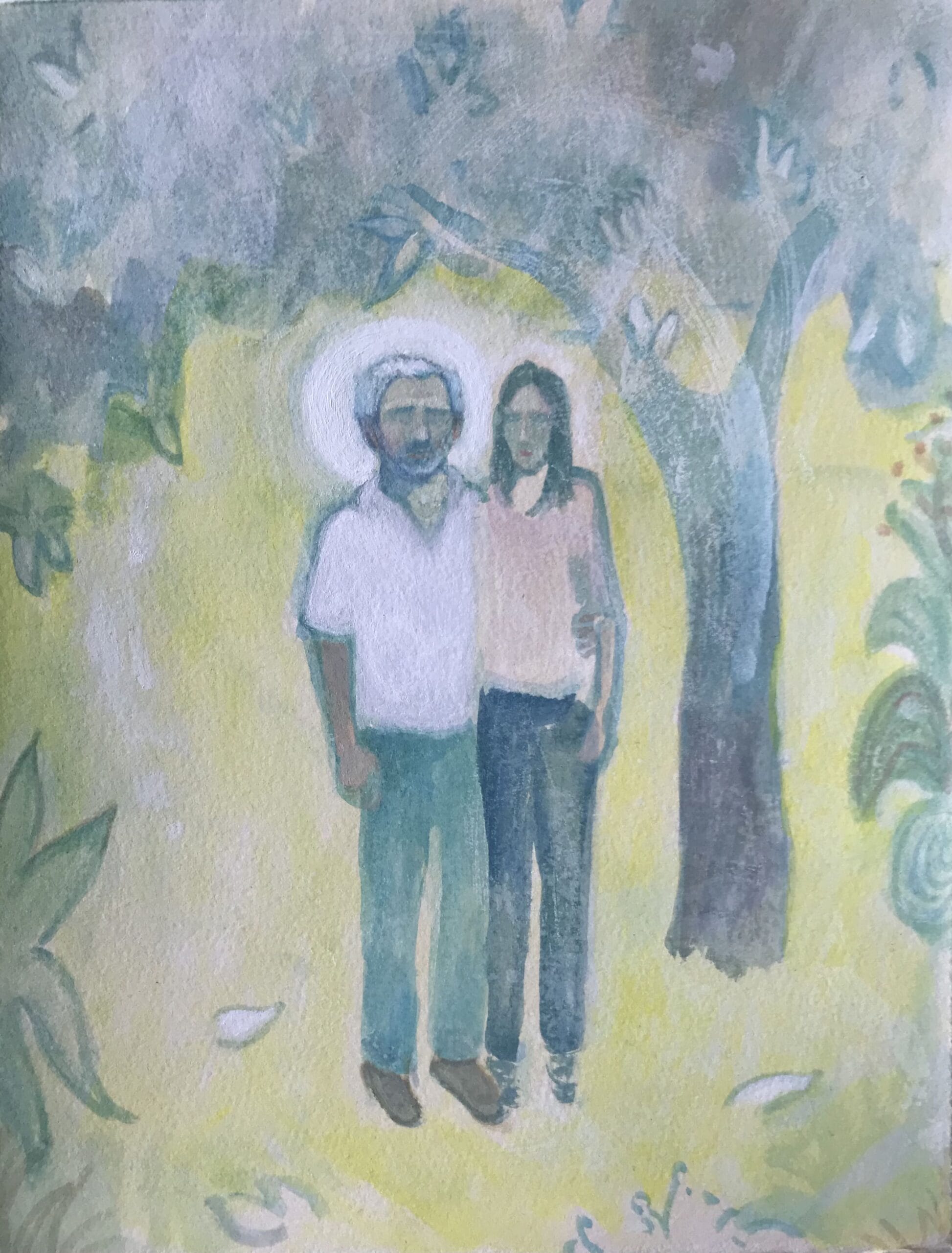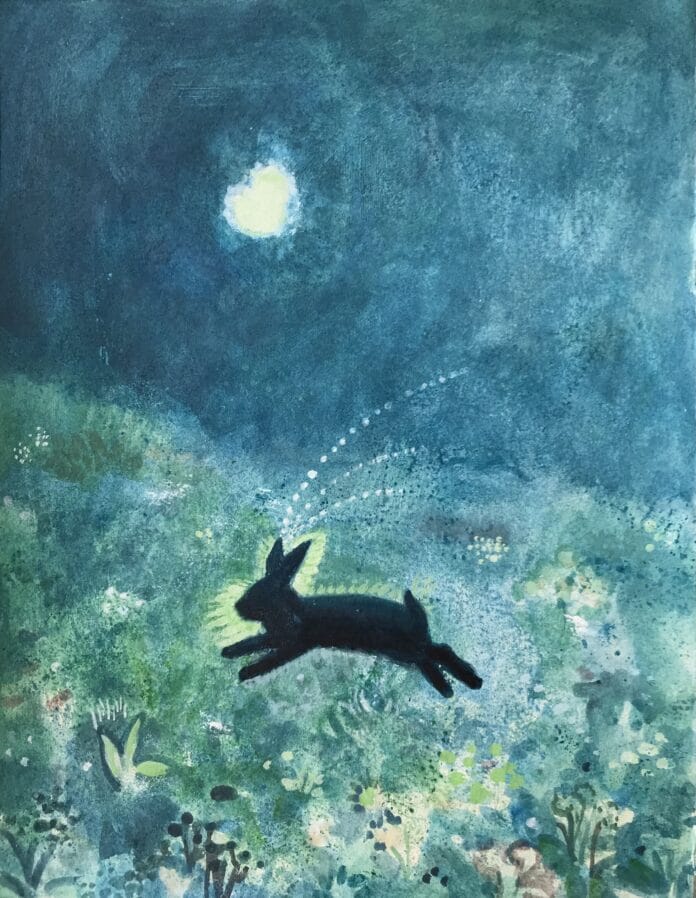Philadelphia-based painter and writer Lynne Campbell creates work that bridges the visible and invisible worlds. Her art is a meditation on love, memory, and the transcendent nature of imagination. A graduate of the Pennsylvania Academy of the Fine Arts, Campbell’s career spans painting, writing, and decades of deep creative inquiry.
Her artistic life has been profoundly shaped by her late husband, John Sevcik, a poet and painter she met while studying at the Academy. The two shared a partnership defined by artistic dialogue and emotional depth, a rare and luminous connection that continued to inspire Campbell’s work after his passing.
When John died, Campbell entered a period of silence. For months, she could not paint. Yet within that stillness, something profound began to stir. The experience of loss, though devastating, opened her to what she describes as a greater awareness and access to the unseen currents of the universe. When she finally returned to painting, her brush began tracing not only memory, but the continuity of love itself.
Her recent works center on that spiritual and emotional connection, an ongoing conversation between two souls that transcends time and form.
Luckiest of All Signs
Among Campbell’s pieces, Luckiest of All Signs stands as both personal symbol and universal metaphor. The work began with an inexplicable vision, a fleeting image of a black bunny that seemed to appear out of nothing. From that moment grew a painting imbued with tenderness, mystery, and meaning.
“The rabbit, in the Chinese zodiac”, is regarded as the luckiest of all signs — a bearer of peace, grace, and good fortune. For Campbell, the motif carries intimate resonance. John was born in the Year of the Rabbit, and “Bunny” was the affectionate name they used for one another. In this context, the bunny became more than an image; it was a sign of enduring love, a comforting reminder that connection persists even when form disappears.
Rendered in acrylic on paper, the painting shows a black bunny leaping across a summer field — light and motion suspended in time. The composition feels airy yet grounded, suggesting the meeting of two worlds: the physical and the imagined. The painting affirms Campbell’s belief that imagination is not a retreat from reality but a deeper extension of it.
In her creative universe, the unseen is real, and the symbols that arise from intuition are as alive as anything tangible. Luckiest of All Signs captures that conviction — a quiet yet profound dialogue between love, memory, and the boundless field of imagination.
The World of the Imagination is Real
In another work, The World of the Imagination is Real, Campbell continues her exploration of reunion through dreams and visions. The painting belongs to a series inspired by her encounters with John in the dream world, moments of clarity and connection that transcend the boundaries of life and death.
These works often depict the two of them together, though not in a literal sense. Rather than fixed portraits, they emerge from emotional and spiritual memory, shaped by the sensations of warmth, peace, and presence that accompany these visions.
Working in acrylic on paper, Campbell allows her intuition to lead the process. She begins without a predetermined plan, letting the images surface gradually through color and gesture. The figures seem to dissolve into their surroundings, suggesting that spirit and matter are not opposites but intertwined aspects of a greater whole.
Through this series, she gives form to the invisible, to love as energy and light, to imagination as truth. The title The World of the Imagination is Real encapsulates her worldview: that creativity opens portals to realms beyond logic, where art becomes a vessel for connection, healing, and revelation.

Art as a Bridge Between Worlds
Throughout her long and accomplished career, Campbell has used painting and writing as twin paths of exploration. Her art has been exhibited widely across the United States and internationally, including in Korea. She is a three-time recipient of painting fellowships from The Pennsylvania Council on the Arts, a distinction that reflects both her technical mastery and her creative integrity.
Her work is held in many public and private collections, including the Woodmere Art Museum in Philadelphia, the Youngdam Hanji Art Museum in Seoul, the Blank Family Foundation in Atlanta, and the Mandarin Oriental Hotel in New York.
Alongside her painting, Campbell is a gifted author. She has published four books of prose poems, among them Yes, and Always, and her forthcoming book, Troubadours Should Sing of Us, delves into her love story with John, exploring art, grief, and the eternal nature of connection.
Love as the Eternal Thread
At the heart of Lynne Campbell’s creative practice lies an unwavering faith in love as a sustaining force. Her paintings, especially those created in the aftermath of loss, affirm that love endures not only in memory but as a living presence that continues to guide the hand and heart.
Through her art, Lynne Campbell transforms grief into radiance. The boundaries between dream and waking life blur, and the visible and invisible worlds converge in luminous harmony. Her work invites viewers to consider imagination not as fantasy, but as a sacred space, a place where connection, meaning, and love persist beyond time.
In essence, she is reminding us of our own capacities.


